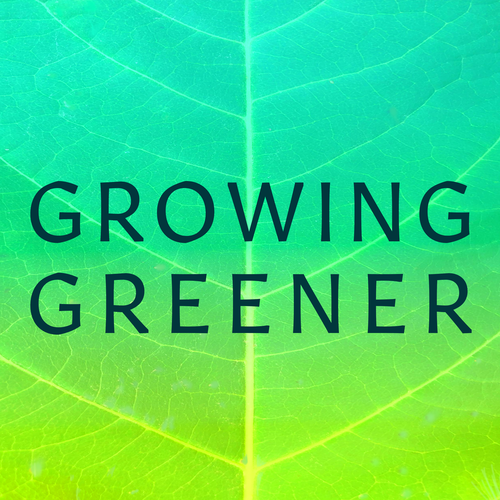As the first Executive Director of Homegrown National Park, Brandon Hough talks about his unconventional journey to conservation, and how this non-profit makes it easy for homeowners to find plants that give the maximum boost to the local ecosystem while also, at least in Brandon’s case, relieving eco-grief.
Daryl Beyers Shares a Fresh Approach to Gardening Fundamentals
Subscribe to Growing Greener on Apple Podcasts | Google Podcasts | Spotify | Amazon
Coordinator of the New York Botanical Garden’s Gardening Education Program, Daryl Beyers has developed a fresh approach to teaching the fundamentals of the craft, one that not only provides a strong foundation for novices to go on and build their own skills, but which has proved valuable to experienced practitioners who want to move beyond the old-fashioned, often environmentally harmful practices they absorbed at the beginning of their careers.
Native Annuals of the Eastern United States
Annuals offer unique advantages for the ecological gardener, growing fast to stabilize disturbed soils, and providing quick color for new plantings. In this conversation, master plantsman Ethan Dropkin of Larry Weaner Landscape Associates shares his pick of the best native annuals native to eastern North America.
Thomas Rainer: A Case for Thoughtful Optimism
In 2015 landscape architect Thomas Rainer and his professional partner Claudia West stirred the gardening world with their best-selling book, “Planting in a Post-Wild World.” Now Rainer shares his arguments for thoughtful optimism regarding gardening and its potential impact on our ecological challenges.
Celebrating Regional Beauty
In the 1990’s Lauren Springer helped pioneer a new, regionally focused gardening style in Colorado, an “undaunted garden” that celebrated the Rocky Mountain landscape and the plants, native and introduced, that were at home there. In this conversation, Springer recalls those times and details how her design style has continued to evolve, and what comes next.
Can Genetic Engineering Help Save North American Trees From Imported Threats?
The American chestnut was a foundational species of eastern forests until an imported blight killed virtually all mature specimens back to stumps in the early 20th century. Jared Westbrook, Science Director of the American Chestnut Foundation discusses how a project to genetically engineer a blight-resistant American chestnut has revealed the complexity of applying this process to tree species.
A New CEO for the Native Plant Trust
When it was founded in 1900, the Native Plant Trust was the first plant conservation organization in the United States. Its new CEO, Tim Johnson describes how, more than a century later, the Trust continues to break new ground, defining how an organization such as this can rise to meet the challenges currently facing our native flora.
Poor Man’s Fertilizer
Create Your Own Locally Adapted Garden Seeds
Hybrid fruit and vegetable seeds are like thoroughbred horses – extraordinary performers but not resilient or good at coping with adverse conditions. When they didn’t succeed in Joseph Lofthouse’s Utah garden, he created his own “landraces”, biodiverse crop strains that “promiscuously pollinate” and speedily evolve to thrive in local conditions and adapt to the gardener’s style of cultivation.
Invasive Plants Waging Chemical Warfare
Why are invasive plants so effective in muscling out native species? Research by Dr. Susan Kalisz of the University of Tennessee Knoxville details how the invaders commonly release chemicals into the soil that disrupt the functioning of native plants and even the soil fungi and bacteria that help them grow.
Easy Hacks for Starting Native Plants from Seed
Restoring the Canopy of an Olmsted Masterpiece
Brooklyn’s Prospect Park, one of Frederick Law Olmsted’s greatest masterpieces, was failing by 1989 when Joseph Doccola signed on to restore its tree canopy. Over the next decade he replanted lost trees, matching adapted native species to each site, helping to turn Prospect Park into a pioneering example for urban parks across the United States.
Bankrupting Your Garden’s Weed Seed Bank
Roots Revealed
Rebecca McMackin and the Innovative Beauty of the Ecological Landscape
As Director of Horticulture at Brooklyn Bridge Park, Rebecca McMackin played a leading role in transforming 85 acres of abandoned piers and pavement into a series of vibrant ecosystems that are a model of what an urban park can be. We talk with her about her subsequent year of study at Harvard and her new endeavors to make ecological landscaping the mainstream.
Biocontrol – Beating Back Invasive Plants
Invasive plants flourish in part because in their transition to North America they leave behind the co-evolved pests that help keep them in check in their homelands. Dr. Lisa Tewksbury, Director of the University of Rhode Island Biocontrol Laboratory, describes the painstaking process of introducing to our landscape organisms that can control the invasive plants without harming our native species.

